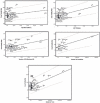The association between various indicators of hospital capacity, age category, and the number of screening tests performed with case fatality rate and recovery rate during the COVID-19 disease pandemic
- PMID: 34604564
- PMCID: PMC8451361
- DOI: 10.15167/2421-4248/jpmh2021.62.2.1569
The association between various indicators of hospital capacity, age category, and the number of screening tests performed with case fatality rate and recovery rate during the COVID-19 disease pandemic
Abstract
Background: The COVID-19-related deaths are growing rapidly around the world, especially in Europe and the United States.
Purpose: In this study we attempt to measure the association of these variables with case fatality rate (CFR) and recovery rate (RR) using up-to-date data from around the world.
Methods: Data were collected from eight global databases. According to the raw data of countries, the CFR and RR and their relationship with different predictors was compared for countries with 1,000 or more cases of COVID-19 confirmed cases.
Results: There were no significant correlation between the CFR and number of hospital beds per 1,000 people, proportion of population aged 65 and older ages, and the number of computed tomography per one million inhabitants. Furthermore, based on the continents-based subgroup univariate regression analysis, the population (R2 = 0.37, P = 0.047), GPD (R2 = 0.80, P < 0.001), number of ICU Beds per 100,000 people (R2 = 0.93, P = 0.04), and number of CT per one million inhabitants (R2 = 0.78, P = 0.04) were significantly correlated with CFR in America. Moreover, the income-based subgroups analysis showed that the gross domestic product (R2 = 0.30, P = 0.001), number of ICU Beds per 100,000 people (R2 = 0.23, P = 0.008), and the number of ventilator (R2 = 0.46, P = 0.01) had significant correlation with CFR in high-income countries.
Conclusions: The level of country's preparedness, testing capacity, and health care system capacities also are among the important predictors of both COVID-19 associated mortality and recovery. Thus, providing up-to-date information on the main predictors of COVID-19 associated mortality and recovery will hopefully improve various countries hospital resource allocation, testing capacities, and level of preparedness.
Keywords: COVID-19; Case fatality rate (CFR); Hospital resource allocation; Recovery rate (RR).
©2021 Pacini Editore SRL, Pisa, Italy.
Conflict of interest statement
Conflict of interest statement The authors declare no conflict of interest.
Figures


Similar articles
-
National case fatality rates of the COVID-19 pandemic.Clin Microbiol Infect. 2021 Jan;27(1):118-124. doi: 10.1016/j.cmi.2020.09.024. Epub 2020 Sep 23. Clin Microbiol Infect. 2021. PMID: 32979575 Free PMC article.
-
Assessing sub-regional-specific strengths of healthcare systems associated with COVID-19 prevalence, deaths and recoveries in Africa.PLoS One. 2021 Mar 1;16(3):e0247274. doi: 10.1371/journal.pone.0247274. eCollection 2021. PLoS One. 2021. PMID: 33647032 Free PMC article.
-
Coronavirus Disease 2019 (COVID-19): A Modeling Study of Factors Driving Variation in Case Fatality Rate by Country.Int J Environ Res Public Health. 2020 Nov 5;17(21):8189. doi: 10.3390/ijerph17218189. Int J Environ Res Public Health. 2020. PMID: 33167564 Free PMC article.
-
Case Fatality Rates for Patients with COVID-19 Requiring Invasive Mechanical Ventilation. A Meta-analysis.Am J Respir Crit Care Med. 2021 Jan 1;203(1):54-66. doi: 10.1164/rccm.202006-2405OC. Am J Respir Crit Care Med. 2021. PMID: 33119402 Free PMC article. Review.
-
One hundred thirty-three observed COVID-19 deaths in 10 months: unpacking lower than predicted mortality in Rwanda.BMJ Glob Health. 2021 Feb;6(2):e004547. doi: 10.1136/bmjgh-2020-004547. BMJ Glob Health. 2021. PMID: 33627363 Free PMC article. Review.
Cited by
-
Time-dependent risk of COVID-19 death with overwhelmed health-care capacity in Japan, 2020-2022.BMC Infect Dis. 2022 Dec 12;22(1):933. doi: 10.1186/s12879-022-07929-8. BMC Infect Dis. 2022. PMID: 36510193 Free PMC article.
References
-
- Wu Z, McGoogan JM. Characteristics of and Important lessons from the coronavirus disease 2019 (COVID-19) outbreak in China: summary of a report of 72,314 cases from the Chinese Center for Disease Control and Prevention. JAMA 2020;323:1239-42. https://doi.org/10.1001/jama.2020.264810.1001/jama.2020.2648 - DOI - PubMed
-
- Khafaie MA, Rahim F. Cross-country comparison of case fatality rates of COVID-19/SARS-COV-2. Osong Public Health Res Perspect 2020;11:74-80. https://doi.org/10.24171/j.phrp.2020.11.2.0310.24171/j.phrp.2020.11.2.03 - DOI - PMC - PubMed
-
- Van Lancker W, Parolin Z. COVID-19, school closures, and child poverty: a social crisis in the making. Lancet Public Health 2020;5:e243-4. https://doi.org/10.1016/S2468-2667(20)30084-010.1016/S2468-2667(20)30084-0 - DOI - PMC - PubMed
-
- Gupta S, Federman DG. Hospital preparedness for COVID-19 pandemic: experience from department of medicine at Veterans Affairs Connecticut Healthcare System. Postgrad Med 2020;132:489-94. https://doi.org/10.1080/00325481.2020.176166810.1080/00325481.2020.1761668 - DOI - PMC - PubMed
-
- Ferrua M, Sicotte C, Lalloué B, Minvielle E. Comparative quality indicators for hospital choice: do general practitioners care? PLoS One 2016;11:e0147296. https://doi.org/10.1371/journal.pone.014729610.1371/journal.pone.0147296 - DOI - PMC - PubMed
MeSH terms
LinkOut - more resources
Full Text Sources
Medical
